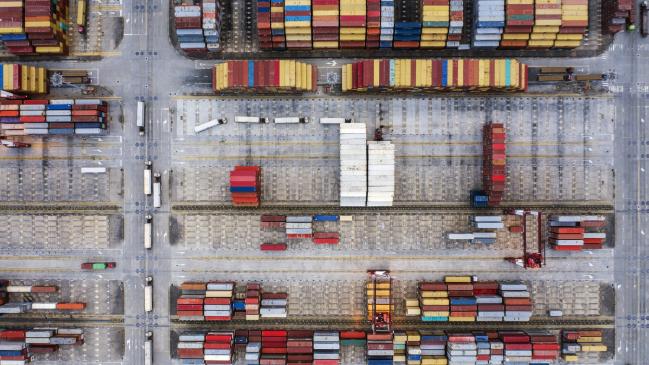(Bloomberg) -- Go inside the global economy with Stephanie Flanders in her new podcast, Stephanomics. Subscribe via Pocket Cast or iTunes.
President Donald Trump has repeatedly portrayed the punitive tariffs he has imposed on China and other countries as tools to create leverage and draw them into new trade deals that benefit the U.S.
Increasingly, however, it is looking like Trump’s tariffs are here to stay and more tangible than any of the deals the president has promised. And that, economists agree, bodes badly for the U.S. and global economies.
With his move to raise tariffs on $200 billion in Chinese imports last week and to order up plans for tariffs on all further trade from China, Trump has deployed import taxes on a scale not seen in decades, with some economists reaching as far back as the 19th century for comparisons. He has also threatened more to come with a May 18 deadline looming for him to make a decision on whether to proceed with new tariffs on imported cars and parts.
In tweets and other public utterances in recent days Trump has repeatedly hailed his tariffs, claiming they have helped power U.S. economic growth and repeated over and over again that other countries such as China pay the bill, a view even his own economic advisers are uncomfortable defending.
“The unexpectedly good first quarter 3.2% GDP was greatly helped by Tariffs from China. Some people just don’t get it!’’ Trump tweeted Monday.
In some cases, Trump is displaying a preference for his tariffs over his own deals.
Among the major hurdles to a congressional vote to ratify his renegotiated version of the North American Free Trade Agreement are the steel and aluminum tariffs that Trump imposed on products coming from Canada and Mexico.
Those tariffs have invited retaliation against U.S. agricultural exports such as corn and pork that are hurting U.S. farmers. They also have caused senior Republicans like Chuck Grassley, the powerful head of the Senate Finance Committee, to say they will block any vote for Trump’s re-branded Nafta, the U.S.-Mexico-Canada Agreement.
But the administration has refused to bend and remove the tariffs unless Canada and Mexico agree to other trade restraints with new investment in domestic steel mills and aluminum smelters one of the benefits of Trump’s trade wars the president is most eager to tout.
“Deals, deals, deals. The real deal is standing up to foreigners who have been eating our lunch from his perspective. And that means imposing tariffs,’’ said Gary Hufbauer of the Peterson Institute for International Economics.
The biggest risk remains that Trump’s tariffs will be greeted by yet more retaliation from China and other countries.
‘Law of the Jungle’
On Monday, China laid out plans for an increase of tariffs by as much as 25% on some $60 billion in imports from the U.S. The EU has also said it will retaliate quickly against any U.S. auto duties with the bloc’s trade commissioner, Cecilia Malmstrom, on Monday accusing Trump of taking a “law of the jungle’’ approach to trade.
Hufbauer and others argue such an escalation in a tit-for-tat tariff war would hurt not just the U.S. economy but the global economy as a whole. While the direct impact of tariffs might seem manageable -- Hufbauer’s own back-of-the-envelope calculation is that tariffs on all Chinese imports would cost U.S. households roughly $2,000 per year in higher prices -- a broader economic slowdown would be far more painful.
Trump’s claim that his tariffs have boosted U.S. growth is based in part on what economists say was a transitory drop in imports related to the stockpiling by U.S. companies at the end of last year of goods facing possible higher tariffs. Advocates of tariffs also claim they encourage domestic investment and thus pay long-term dividends.
Put to the Test
With his tariffs Trump has launched the world’s largest economy into a live-fire experiment to see if that is true. Or whether what most economists see as the lessons of history still hold.
Most economists argue tariffs lead to higher costs for American consumers and companies while also hitting growth overseas, a toxic mix for the U.S. that could even tip it into recession.
“I’m with most economists and I think tariffs and a reduction in free trade are going to be a bad outcome for all involved and not just the U.S.,’’ said Stephen Gallagher, chief U.S. economist at Societe General SA in New York. In a note to investors this week Gallagher argued that an extension of a 25% tariff to all imports from China could lop 0.5 percentage point off U.S. growth.
There’s another looming tariff reality also worth considering, Hufbauer said. The politics of tariffs and the vested interests they create mean tariffs are easier to impose than to remove.
Lifting his steel tariffs or any of those he has aimed at China already seems increasingly difficult for Trump. One sticking point in negotiations with China has been Trump’s refusal to remove existing tariffs if and when a deal is struck, something Beijing insists on.
But eliminating tariffs may also be hard for anyone who succeeds Trump, said Hufbauer.
The best example of why that is, according to Hufbauer, is the 25% tariff that has long protected light trucks in the U.S. from foreign competition. It was introduced in the 1960s to retaliate against European measures aimed at American poultry and has survived multiple U.S. presidencies. Ergo the name of a once temporary measure that decades later seems awfully permanent: the chicken tax.
